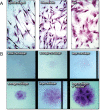Recent updates on the biological basis of heterogeneity in bone marrow stromal cells/skeletal stem cells
- PMID: 35837340
- PMCID: PMC9255791
- DOI: 10.12336/biomatertransl.2022.01.002
Recent updates on the biological basis of heterogeneity in bone marrow stromal cells/skeletal stem cells
Abstract
Based on studies over the last several decades, the self-renewing skeletal lineages derived from bone marrow stroma could be an ideal source for skeletal tissue engineering. However, the markers for osteogenic precursors; i.e., bone marrowderived skeletal stem cells (SSCs), in association with other cells of the marrow stroma (bone marrow stromal cells, BMSCs) and their heterogeneous nature both in vivo and in vitro remain to be clarified. This review aims to highlight: i) the importance of distinguishing BMSCs/SSCs from other "mesenchymal stem/stromal cells", and ii) factors that are responsible for their heterogeneity, and how these factors impact on the differentiation potential of SSCs towards bone. The prospective role of SSC enrichment, their expansion and its impact on SSC phenotype is explored. Emphasis has also been given to emerging single cell RNA sequencing approaches in scrutinizing the unique population of SSCs within the BMSC population, along with their committed progeny. Understanding the factors involved in heterogeneity may help researchers to improvise their strategies to isolate, characterize and adopt best culture practices and source identification to develop standard operating protocols for developing reproducible stem cells grafts. However, more scientific understanding of the molecular basis of heterogeneity is warranted that may be obtained from the robust high-throughput functional transcriptomics of single cells or clonal populations.
Keywords: bone marrow stromal cells; clonal analysis; heterogeneity; single cell analysis; skeletal stem cells.
Conflict of interest statement
Conflicts of interest statement: The authors have no conflicts of interest to declare.
Figures





Similar articles
-
Skeletal stem cell isolation: A review on the state-of-the-art microfluidic label-free sorting techniques.Biotechnol Adv. 2016 Sep-Oct;34(5):908-923. doi: 10.1016/j.biotechadv.2016.05.008. Epub 2016 May 25. Biotechnol Adv. 2016. PMID: 27236022 Review.
-
Secreted frizzled related-protein 2 (Sfrp2) deficiency decreases adult skeletal stem cell function in mice.Bone Res. 2021 Dec 2;9(1):49. doi: 10.1038/s41413-021-00169-7. Bone Res. 2021. PMID: 34857734 Free PMC article.
-
Periosteal skeletal stem cells can migrate into the bone marrow and support hematopoiesis after injury.Elife. 2025 May 22;13:RP101714. doi: 10.7554/eLife.101714. Elife. 2025. PMID: 40401637 Free PMC article.
-
Enrichment of Skeletal Stem Cells from Human Bone Marrow Using Spherical Nucleic Acids.ACS Nano. 2021 Apr 27;15(4):6909-6916. doi: 10.1021/acsnano.0c10683. Epub 2021 Mar 22. ACS Nano. 2021. PMID: 33751885
-
Postnatal skeletal stem cells.Methods Enzymol. 2006;419:117-48. doi: 10.1016/S0076-6879(06)19006-0. Methods Enzymol. 2006. PMID: 17141054 Review.
Cited by
-
Combining "waste utilization" and "tissue to tissue" strategies to accelerate vascularization for bone repair.J Orthop Translat. 2024 Jun 24;47:132-143. doi: 10.1016/j.jot.2024.04.002. eCollection 2024 Jul. J Orthop Translat. 2024. PMID: 39027342 Free PMC article.
-
Extracellular vesicles from apoptotic BMSCs ameliorate osteoporosis via transporting regenerative signals.Theranostics. 2024 Jun 3;14(9):3583-3602. doi: 10.7150/thno.96174. eCollection 2024. Theranostics. 2024. PMID: 38948067 Free PMC article.
-
Bone and the Unfolded Protein Response: In Sickness and in Health.Calcif Tissue Int. 2023 Jul;113(1):96-109. doi: 10.1007/s00223-023-01096-x. Epub 2023 May 27. Calcif Tissue Int. 2023. PMID: 37243756 Free PMC article. Review.
-
Mesenchymal Stem Cells From Different Sources in Meniscus Repair and Regeneration.Front Bioeng Biotechnol. 2022 Apr 27;10:796367. doi: 10.3389/fbioe.2022.796367. eCollection 2022. Front Bioeng Biotechnol. 2022. PMID: 35573249 Free PMC article. Review.
-
Amyloid-β neuropathology induces bone loss in male mice by suppressing bone formation and enhancing bone resorption.Bone Rep. 2024 Apr 28;21:101771. doi: 10.1016/j.bonr.2024.101771. eCollection 2024 Jun. Bone Rep. 2024. PMID: 38725879 Free PMC article.
References
-
- Bianco P., Robey P. G. Skeletal stem cells. In: Lanza R. P., editor. Handbook of adult and fetal stem cells. Academic Press; San Diego: 2004. pp. 415–424.
-
- Sacchetti B., Funari A., Michienzi S., Di Cesare S., Piersanti S., Saggio I., Tagliafico E., Ferrari S., Robey P. G., Riminucci M., Bianco P. Self-renewing osteoprogenitors in bone marrow sinusoids can organize a hematopoietic microenvironment. Cell. 2007;131:324–336. - PubMed
Publication types
Grants and funding
LinkOut - more resources
Full Text Sources
